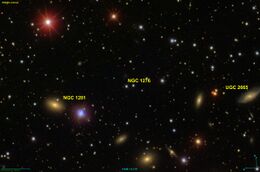Astronomy:NGC 1276
From HandWiki
(Redirected from Astronomy:Pul -3 270349)
Short description: Double star in the constellation Perseus
| Observation data {{#ifeq:J2000.0|J2000.0 (ICRS)|Epoch J2000.0 Equinox J2000.0 (ICRS)| [[History:Epoch|Epoch J2000.0]] [[Astronomy:Equinox (celestial coordinates)|Equinox J2000.0}} | |
|---|---|
| Constellation | Perseus[1] |
| NGC 1276 | |
| Right ascension | 03h 19m 51.2s[1] |
| Declination | 41° 38′ 29″[1] |
| Apparent magnitude (V) | {{{appmag_v1}}} |
| Pul -3 270349 | |
| Right ascension | 03h 19m 50.5421584698s[2] |
| Declination | 41° 38′ 31.367763313″[2] |
| Apparent magnitude (V) | {{{appmag_v2}}} |
| Pul -3 270357 | |
| Right ascension | 03h 19m 51.8974508403s[3] |
| Declination | 41° 38′ 29.364043732″[3] |
| Apparent magnitude (V) | {{{appmag_v3}}} |
| Astrometry | |
| Pul -3 270349 | |
| Proper motion (μ) | RA: 0.576[2] mas/yr Dec.: -3.787[2] mas/yr |
| Parallax (π) | 0.8814[2] ± 0.0323[2] mas |
| Distance | 1,134.5587 parsecs (3,700.436 ly)[2] ly |
| Pul -3 270357 | |
| Proper motion (μ) | RA: 2.389[3] mas/yr Dec.: -4.469[3] mas/yr |
| Parallax (π) | 0.5635[3] ± 0.0338[3] mas |
| Distance | 1,774.6229 parsecs (5,788.046 ly)[3] ly |
| Characteristics | |
| Apparent magnitude (B) | 15.6 (Pul -3 270349)/15.5 (Pul -3 270357)[4] |
| Apparent magnitude (R[4]) | 14.8 (Pul -3 270349)[4]/14.7 (Pul -3 270357)[4] |
| Details | |
| Pul -3 270349 | |
| Radius | 1.09[5] R☉ |
| Luminosity | 0.838[5] L☉ |
| Temperature | 5299.00[5] K |
| Pul -3 270357 | |
| Radius | 1.48[5] R☉ |
| Luminosity | 1.964[5] L☉ |
| Temperature | 5614.53[5] K |
| Other designations | |
| Pul -3 270349: WISEA J031950.54+413831.4, 2MASS J03195054+4138313, GALEXASC J031950.58+413831.6, GALEXMSC J031950.52+413831.0, SSTSL2 J031950.52+413831.3, TIC 178110482, Gaia DR2 239424674200835712[2][6] | |
| Pul -3 270357: WISEA J031951.89+413829.3, 2MASS J03195190+4138293, GALEXASC J031951.93+413829.8, GALEXMSC J031951.88+413829.5, SSTSL2 J031951.88+413829.3, TIC 178110483, Gaia DR2 239424669903392256[3][7] | |
| Database references | |
| SIMBAD | data |
| Pul -3 270349 | |
| Pul -3 270357 | |
NGC 1276 is an optical[2][3] double star system[1][8][9][10] located in the constellation Perseus. [1][8][10] The system was discovered by astronomer John Dreyer[1][10][11] on December 12, 1876.[1][11] The pair consists of two 15th magnitude stars[1][4] known as Pul -3 270349 and Pul -3 270357 that are unrelated as they lie at different distances from each other.[4][2][3] Pul -3 270349 lies at a distance of 1,134.5587 parsecs (3,700.436 ly)[2] and Pul -3 270357 lies at a distance of 1,774.6229 parsecs (5,788.046 ly).[3]
The two stars are about the same size and luminosity as the Sun.[5]
See also
References
- ↑ 1.0 1.1 1.2 1.3 1.4 1.5 1.6 1.7 "New General Catalog Objects: NGC 1250 - 1299". https://cseligman.com/text/atlas/ngc12a.htm#1276.
- ↑ 2.00 2.01 2.02 2.03 2.04 2.05 2.06 2.07 2.08 2.09 2.10 "Pul -3 270349". http://simbad.u-strasbg.fr/simbad/.
- ↑ 3.00 3.01 3.02 3.03 3.04 3.05 3.06 3.07 3.08 3.09 3.10 "Pul -3 270357". http://simbad.u-strasbg.fr/simbad/.
- ↑ 4.0 4.1 4.2 4.3 4.4 4.5 "coord 03 19 51.19730154413 41 38 29.0093822673 (ICRS, J2000, 2000.0), radius: .5 arcmin". http://simbad.u-strasbg.fr/simbad/sim-coo?Coord=03+19+51.19730154413+%2B41+38+29.0093822673&Radius=.5&Radius.unit=arcmin&submit=submit+query.
- ↑ 5.0 5.1 5.2 5.3 5.4 5.5 5.6 Brown, A. G. A.; Vallenari, A.; Prusti, T.; Bruijne, J. H. J. de; Babusiaux, C.; Bailer-Jones, C. a. L.; Biermann, M.; Evans, D. W. et al. (2018-08-01). "Gaia Data Release 2 - Summary of the contents and survey properties" (in en). Astronomy & Astrophysics 616: A1. doi:10.1051/0004-6361/201833051. ISSN 0004-6361. Bibcode: 2018A&A...616A...1G. https://www.aanda.org/articles/aa/abs/2018/08/aa33051-18/aa33051-18.html.
- ↑ "By Name | NASA/IPAC Extragalactic Database". https://ned.ipac.caltech.edu/byname?objname=WISEA+J031950.54+413831.4&hconst=67.8&omegam=0.308&omegav=0.692&wmap=4&corr_z=1.
- ↑ "By Name | NASA/IPAC Extragalactic Database". https://ned.ipac.caltech.edu/byname?objname=WISEA+J031951.89+413829.3&hconst=67.8&omegam=0.308&omegav=0.692&wmap=4&corr_z=1.
- ↑ 8.0 8.1 "Revised NGC Data for NGC 1276". http://spider.seds.org/ngc/revngcic.cgi?NGC1276.
- ↑ "HyperLeda -object description". http://leda.univ-lyon1.fr/ledacat.cgi?NGC%201276&ob=ra.
- ↑ 10.0 10.1 10.2 "Notes on the NGC objects, particularly those missing, misidentified, or otherwise unusual (ngcnotes.all).". http://haroldcorwin.net/ngcic/ngcnotes.all.
- ↑ 11.0 11.1 "Photos". http://www.klima-luft.de/steinicke/ngcic/persons/dreyer.htm.
External links
- NGC 1276 on WikiSky: DSS2, SDSS, GALEX, IRAS, Hydrogen α, X-Ray, Astrophoto, Sky Map, Articles and images
 |


